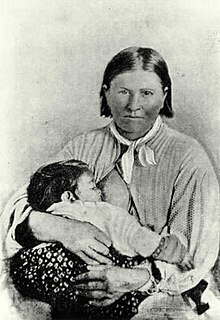
Back سينثيا آن باركر ARZ Cynthia Ann Parker German Cynthia Ann Parker Spanish Cynthia Ann Parker Finnish Cynthia Ann Parker French Cynthia Ann Parker Italian Cynthia Ann Parker Portuguese Паркер, Синтия Энн Russian Cynthia Ann Parker Swedish Cynthia Ann Parker Turkish
Cynthia Ann Parker | |
|---|---|
| Na'ura | |
 Cynthia Ann Parker, or Narua (Was Found), and daughter, Topsannah (Prairie Flower), in 1861 | |
| Born | October 28, 1827[nb 1][1][2] |
| Disappeared | May 19, 1836[1] (age 8) Fort Parker, Republic of Texas |
| Status | Relocated during the Pease River Massacre on December 18, 1860 (age 33)[3][4] |
| Died | March 1871 (aged 43)[5] Anderson County, Texas, U.S. |
| Resting place | Fort Sill Post Cemetery 34°40′10″N 98°23′43″W / 34.669466°N 98.395341°W |
| Known for |
|
| Spouse | Peta Nocona |
| Children |
|
| Parents |
|
| Relatives | John Parker (grandfather) James W. Parker (uncle) Daniel Parker (uncle) |
Cynthia Ann Parker, Naduah, Narua, or Preloch[7] (Comanche: Na'ura, IPA [naʔura], lit. 'Was found';[8] October 28, 1827[nb 1] – March 1871),[1] was a woman who was captured, aged around nine, by a Comanche band during the Fort Parker massacre in 1836, where several of her relatives were killed. She was taken with several of her family members, including her younger brother John Richard Parker. Parker was later adopted into the tribe and had three children with a chief. Twenty-four years later she was relocated and taken captive by Texas Rangers, aged approximately 33, and unwillingly forced to separate from her sons and conform to European-American society. Her Comanche name means "was found" or "someone found" in English.
Thoroughly assimilated as Comanche, Parker had married Peta Nocona, a chief. They had three children together, including son Quanah Parker, who became the last free Comanche chief.[1]
Parker was captured by the Texas Rangers during the Battle of Pease River, also known as the "Pease River Massacre". During this raid, the Rangers killed an estimated six to twelve people, mostly women and children. Afterwards, Parker was taken back to her extended biological family against her will. For the remaining 10 years of her life, she mourned for her Comanche family, and refused to adjust to white society. She escaped at least once but was recaptured and brought back. Unable to grasp how thoroughly she identified with the Comanche, the European-American settlers believed that she had been saved or redeemed by being returned to their society. Heartbroken over her daughter's death from influenza and pneumonia, Parker died within seven years.
She died in 1871. Although initially buried in Anderson County, Texas, her remains were moved twice after her death. In 1910 her son Quanah had her moved to Post Oak Mission Cemetery, Comanche County, Oklahoma; and in 1957 the mother and son were both reinterred in Fort Sill Cemetery in Oklahoma. In 1965 the state of Texas arranged for her daughter's remains to be moved from Texas and reinterred next to the mother and son.
- ^ a b c d e Parker, Cynthia Ann (ca. 1825–ca. 1871) from the Handbook of Texas Online (November 3, 2011). Retrieved January 14, 2015.
- ^ Frankel 2013, pp. 86–87.
- ^ Stratton, W.K. (15 December 2020). "What Happened at Pease River Wasn't a Battle. It Was a Massacre". Texas Monthly. Archived from the original on December 15, 2020. Retrieved July 3, 2023.
- ^ Carlson, Paul H.; Crum, Tom (July 2009). "The "Battle" at Pease River and the Question of Reliable Sources in the Recapture of Cynthia Ann Parker". The Southwestern Historical Quarterly. 113 (1). Texas State Historical Association: 32-52. doi:10.1353/swh.2009.0070. JSTOR 27794584. S2CID 143113603.
- ^ Frankel 2013, pp. 19–20, citing Parker St. John, Susan, Notebook, Dolph Briscoe Center for American History
- ^ "On This Day in 1836: Cynthia Ann Parker is captured in a Comanche Raid". Texas State Library Archives Commission. Retrieved July 11, 2023.
- ^ DeShields, James T. (31 October 2017) [1886]. Cynthia Ann Parker – via Project Gutenberg.
- ^ Taa Nʉmʉ Tekwapʉ?ha Tʉboopʉ (Our Comanche Dictionary). 2010 revision. Elgin, Oklahoma: Comanche Language and Cultural Preservation Committee. It is an anglicized form of the Comanche construction na-ura, literally 'was found'.
Cite error: There are <ref group=nb> tags on this page, but the references will not show without a {{reflist|group=nb}} template (see the help page).
© MMXXIII Rich X Search. We shall prevail. All rights reserved. Rich X Search